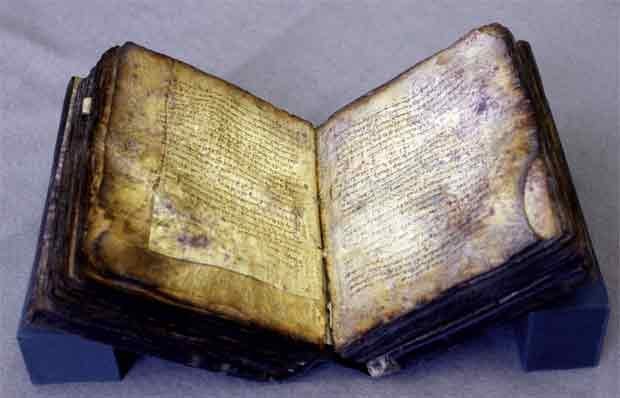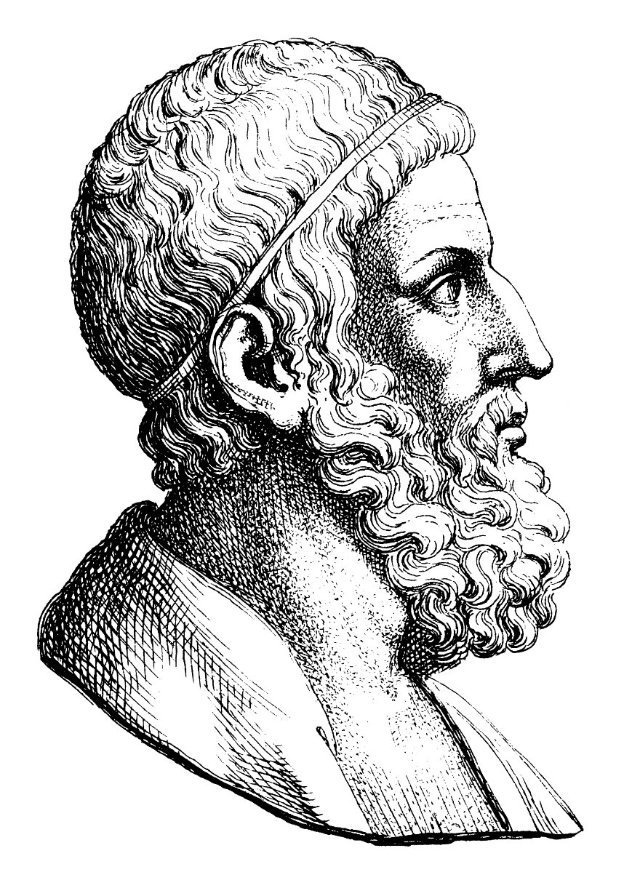The Archimedes Palimpsest
εὕρηκα!
In the 1840s the german evangelic theologian Konstantin von Tischendorf visited the city of Istanbul. He had made it his business to find the oldest Bible manuscript in the world, but he also had an interest in mathematics and so during his search in the library of the Metochion of the Holy Sepulchre a prayer book fell into his hands, obviously hiding a secret. It was only hard to recognize, but it seemed that something else was written on the pages once.

These kinds of books are called palimpsest. For example, if you erase something written in pencil, there is one in front of you already. From the 5th century, writing materials became scarce and correspondingly expensive. Papyrus was hard to get and parchment, highly sought after, unaffordable. This led to the practice of reusing existing books that were considered superfluous. Old bindings were removed, washed and scraped off sheet by sheet until the ink was no longer visible and the pages were rewritten. Recycling, then. Some people also went to work with citric acid to extinguish even more thoroughly. But even then, there are traces left behind...
Tischendorf was thus holding such a palimpsest, a book that previously had a different content. He could not really understand what was written, but at least he realized that it was mathematics and that it must be important. And so he basically did something very reprehensible - he tore out a page without permission and took it with him. In the end, no misfortune, as it turned out later.
Let's go back to Istanbul. Long after Tischendorf's death in 1899, a greek researcher began compiling a catalogue of manuscripts from the Metochion library. He too had noticed that the prayer book originally contained other texts and so he included in his catalogue some fragments of them that he could read, also unaware of what they were actually about. A short time later Johan Heiberg, a danish maths historian, got an insight into the catalogue and he was astonished when he realized that it must have been works of the most important mathematician of antiquity: Archimedes!

Heiberg travelled to Istanbul in 1906 to study the palimpsest and found confirmation that it contained works by Archimedes that he thought had been lost. On July 16, 1907, even the New York Times reported on the sensational discovery. Heiberg was refused permission to remove the book from the library, but he was allowed to photograph it. In the years that followed, he spent transcribing all the information he could still identify, which he gradually published in a complete edition of Archimedes. It was quite clear that the palimpsest had to be further examined. But only newer, hitherto unknown technologies could make visible which cannot be seen with the naked eye.
Odyssey
But the prayer book disappeared! It was stolen from the Metochion library between 1920-22, probably during the Greek-Turkish War, and did not reappear in the possession of a Paris antique dealer until 1932. He had tried to sell it, but was not satisfied with the bids and once again the manuscript disappeared. It was due to the improper storage in the cellar of businessman Marie Louis Sirieix, that the book was seriously damaged. Sometime after 1945, it had come into his possession and was now getting moldy. Before that, however, it must have had fallen into the hands of a forger who painted religious portraits with gold leaf on four of the pages to increase the value. The book was inherited by Sirieix's daughter in 1956, who put it up for auction at Christie's in 1998, and so it was purchased by an anonymous bidder on 29 October for 2 million US dollars.
The End is well ...
William Noel, the curator of the Walters Art Museum in Baltimore, is responsible for the further fate of the manuscript. Noel expressed great interest in a professional investigation and contacted the intermediary of the anonymous bidder with a request for inspection. His efforts finally led to success and on January 19, 1999, the owner handed over the palimpsest, which was now in a pitiful condition. Noel immediately ordered a conservation and consequently an intensive examination. The financing was completely taken over by the owner. This was fortunate, because the investigations were of considerable effort and required the cooperation of several technical institutes, which had been commissioned to develop imaging procedures in order to make any information that could be recovered visible. The manuscript was screened in every way imaginable and even for the foils that had been painted over with gold leaf, a solution was recently found. Highly focused X-rays brought the underlying text back to light. Altogether it took almost ten years of work!
So all is well?
It looks like it. On the official website of the project everyone can see for themselves and take a look at it via google-books. Not all questions have been answered yet and not every fragment could be made clearly legible. After all, the book could be conserved and is now hopefully available for future research without further odyssey. Sensational discoveries have been made and there may be more.
The ways in which some treasures disappear for years or centuries and then they are here again, are always source of great imagination. And the story of this book is not the exception. I was gradually getting more involved in your narrative, imagining such Odyssey. I hope time Will give more answers about the knowledge in that special book! Great post!!
A big Hug and the best vibes for everything important in Life!!
Wonderful story. Exactly the kind of article that I love: the search of the unknown. Thank you for bringing it to us.
Well written interesting topic. Thanks and resteemed. You have a new follower.
Excellent one..well written..
Thank you for your continued support of SteemSilverGold